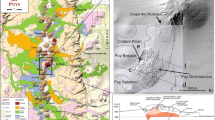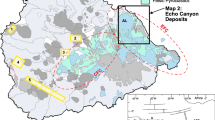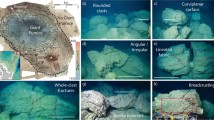Abstract
Hekla is one of the most frequently active felsic volcanic systems in the world, with several known pre-historic large Plinian eruptions and 18 historical subplinian to small Plinian eruptions. A common view is that Plinian eruptions of Hekla are relatively short lived and purely explosive events. In detail, these events exhibit subtle differences in terms of deposit characteristics, reflecting significant differences in eruption behaviour. Of the 18 historical eruptions, two had bulk magma compositions with >66 wt% SiO2: a Plinian eruption in ad 1104 and a smaller, less well characterised, but atypical subplinian eruption in ad 1158. The ad 1158 eruption was a relatively sustained, dry (magmatic) eruption with a more powerful opening phase followed by a lower intensity, waning phase accompanied by minor destabilisation and collapse of the conduit walls. We examine here the dynamics of the ad 1158 eruption, focussing on the role of shallow conduit processes in modulating eruption dynamics. Vesicularity data constrain the relative influence of bubble nucleation, growth, and coalescence. The juvenile pyroclasts are composed of two types of microvesicular pumice (white and grey) with contrasting vesicle number density, vesicle-size distribution, and phenocryst and microlite contents. Textural analysis shows that these pumices reflect heterogeneity developed pre- to syn-eruptively in the conduit and that entrainment of longer resident magma by faster ascending magma permitted magma of contrasting maturity to be fragmented simultaneously. In this regard, the mixed melt of the ad 1158 eruption contrasts with the compositionally homogeneous melt phase of the more powerful ad 1104 Plinian event, which was typified by more uniform conduit and eruption dynamics accompanying higher average ascent rates.














Similar content being viewed by others
References
Adams NK, Houghton BF, Hildreth W (2006) Abrupt transitions during sustained explosive eruptions: examples from the 1912 eruption of Novarupta, Alaska. B Volcanol 69:189–206
Blower JD, Keating JP, Mader HM, Phillips JC (2001) Inferring volcanic degassing processes from vesicle size distributions. Geophys Res Lett 28:347–350
Blower JD, Keating JP, Mader HM, Phillips JC (2002) The evolution of bubble size distributions in volcanic eruptions. J Volcanol Geoth Res 120:1–23
Cashman KV, Mangan MT (1994) Physical aspects of magmatic degassing; II, constraints on vesiculation processes from textural studies of eruptive products. Rev Mineral Geochem 30:447–478
Eichelberger JC, Carrigan CR, Westrich HR, Price RH (1986) Non-explosive silicic volcanism. Nature 323:598–602
Gaonac’h H, Lovejoy S, Stix J, Scherzter D (1996) A scaling growth model for bubbles in basaltic lava flows. Earth Planet Sc Lett 139:395–409
Gardner JE, Thomas RM, Jaupart C, Tait S (1996) Fragmentation of magma during Plinian volcanic eruptions. B Volcanol 58:144–162
Gonnermann HM, Houghton BF (2012) Magma degassing during the Plinian eruption of Novarupta, Alaska, 1912. Geochem Geophy Geosy. doi:10.1029/2012GC004273
Gonnermann HM, Manga M (2003) Explosive volcanism may not be an inevitable consequence of magma fragmentation. Nature 426:432–435
Gonnermann HM, Manga M (2007) The fluid mechanics inside a volcano. Annu Rev Fluid Mech 39:321–356
Gronvold K, Larsen G, Einarsson P, Thorarinsson S, Saemundsson K (1983) The Hekla eruption 1980–1981. B Volcanol 46:349–363
Gudmundsdóttir ER, Larsen G, Eiríksson J (2011) Two new Icelandic tephra markers: the Hekla Ö tephra layer, 6060 cal. yr BP, and Hekla DH tephra layer, ∼6650 cal. yr BP. Land–sea correlation of mid-Holocene tephra markers. The Holocene 21:629–639
Hamada M, Laporte D, Cluzel N, Koga KT, Kawamoto T (2010) Simulating bubble number density of rhyolitic pumices from Plinian eruptions: constraints from fast decompression experiments. B Volcanol 72:735–746
Hammer JE, Cashman KV, Hoblitt RP, Newman S (1999) Degassing and microlite crystallization during pre-climactic events of the 1991 eruption of Mt. Pinatubo, Philippines. B Volcanol 60:355–380
Höskuldsson Á, Óskarsson N, Pedersen R, Grönvold K, Vogfjörð K, Ólafsdóttir R (2007) The millennium eruption of Hekla in February 2000. B Volcanol 70:169–182
Houghton BF, Wilson CJN (1989) A vesicularity index for pyroclastic deposits. B Volcanol 51:451–462
Houghton BF, Carey RJ, Cashman KV, Wilson CJN, Hobden BJ, Hammer JE (2010) Diverse patterns of ascent, degassing, and eruption of rhyolite magma during the 1.8 ka Taupo eruption, New Zealand: evidence from clast vesicularity. J Volcanol Geoth Res 195:31–47
Inman DL (1952) Measures for describing the size distribution of sediments. J Sediment Petrol 22:125–145
Janebo MH, Thordarson T, Houghton BF, Bonadonna C, Larsen G, Carey RJ (2016) Dispersal of key subplinian–Plinian tephras from Hekla volcano, Iceland: implications for eruption source parameters. B Volcanol 78:66. doi:10.1007/s00445-016-1059-7
Kenney BM, Wadsworth FB, Vasseur J, Schipper CI, Jellinek AM, von Aulock FW, Hess K-U, Russell JK, Lavallée Y, Nichols ARL, Dingwell DB (2016) Surface tension driven processes densify and retain permeability in magma and lava. Earth Planet Sc Lett 433:116–124
Klug C, Cashman KV (1994) Vesiculation of May 18, 1980, Mount St. Helens magma. Geology 22:468–472
Klug C, Cashman KV, Bacon CR (2002) Structure and physical characteristics of pumice from the climactic eruption of Mount Mazama (Crater Lake), Oregon. B Volcanol 64:486–501
Larsen G (1992) Gjóskulagid úr Heklugosinu 1158 (the tephra layer from the 1158 AD eruption of Hekla). Jardfrædafélag Islands, Vorrádstefna, Yfirlit og Ágrip Reykjavik: Geoscience Society of Iceland 25–27
Larsen G (2002) A brief overview of eruptions from ice-covered and ice-capped volcanic systems in Iceland during the past 11 centuries: frequency, periodicity and implications. Geol Soc Lond, Spec Publ 202:81–90
Larsen G, Eiríksson J (2008a) Holocene tephra archives and tephrochronology in Iceland—a brief overview. Jokull 58:229–250
Larsen G, Eiríksson J (2008b) Late Quaternary terrestrial tephrochronology of Iceland—frequency of explosive eruptions, type and volume of tephra deposits. J Quat Sci 23:109–120
Larsen JF, Gardner JE (2000) Experimental constraints on bubble interactions in rhyolite melts: implications for vesicle size distributions. Earth Planet Sc Lett 180:201–214
Larsen G, Thorarinsson S (1977) H4 and other acid Hekla tephra layers. Jokull 27:28–46
Larsen G, Vilmundardóttir EG (1992) Hekla tephra layers from the period 2900–1800 BP: H-x, H-y and H-z. The 20th Nordic Geological Winter Meeting, Abstracts 106, Reykjavík, Iceland.
Larsen G, Dugmore A, Newton A (1999) Geochemistry of historical-age silicic tephras in Iceland. The Holocene 9:463–471
Lirer L, Pescatore T, Booth B, Walker GPL (1973) Two Plinian pumice-fall deposits from Somma-Vesuvius, Italy. Geol Soc Am Bull 84:759–772
Mangan M, Sisson T (2000) Delayed, disequilibrium degassing in rhyolite magma: decompression experiments and implications for explosive volcanism. Earth Planet Sc Lett 183:441–455
Mangan MT, Cashman KV, Newman S (1993) Vesiculation of basaltic magma during eruption. Geology 21:157–160
Mangan M, Mastin L, Sisson T (2004a) Gas evolution in eruptive conduits: combining insights from high temperature and pressure decompression experiments with steady-state flow modeling. J Volcanol Geoth Res 129:23–36
Mangan MT, Sisson TW, Hankins WB (2004b) Decompression experiments identify kinetic controls on explosive silicic eruptions. Geophys Res Lett. doi:10.1029/2004GL019509
Mourtada-Bonnefoi CC, Laporte D (1999) Experimental study of homogeneous bubble nucleation in rhyolitic magmas. Geophys Res Lett 26:3505–3508
Mourtada-Bonnefoi CC, Laporte D (2002) Homogeneous bubble nucleation in rhyolitic magmas: an experimental study of the effect of H2O and CO2. J Geophys Res. doi:10.1029/2001JB000290
Mourtada-Bonnefoi CC, Laporte D (2004) Kinetics of bubble nucleation in a rhyolitic melt: an experimental study of the effect of ascent rate. Earth Planet Sc Lett 218:521–537
Mueller S, Melnik O, Spieler O, Scheu B, Dingwell DB (2005) Permeability and degassing of dome lavas undergoing rapid decompression: an experimental determination. B Volcanol 67:526–538
Polacci M, Papale P, Rosi M (2001) Textural heterogeneities in pumices from the climactic eruption of Mount Pinatubo, 15 June 1991, and implications for magma ascent dynamics. B Volcanol 63:83–97
Róbertsdóttir BG, Larsen G, Eiríksson J (2002) A new detailed stratigraphical and geochemical record of 30 tephra layers from the Hekla volcanic system, Iceland, 2980–850 cal. BP. The 25th Nordic Geological Winter Meeting, Abstracts 178, Reykjavik, Iceland.
Rust AC, Cashman KV, Wallace PJ (2004) Magma degassing buffered by vapor flow through brecciated conduit margins. Geology 32:349–352
Sahagian DL, Proussevitch A (1998) 3D particle size distributions from 2D observations: stereology for natural application. J Volcanol Geoth Res 84:173–196
Sarda P, Graham D (1990) Mid-ocean ridge popping rocks: implications for degassing at ridge crests. Earth Planet Sc Lett 97:268–289
Schneider CA, Rasband WS, Eliceiri KW (2012) NIH image to ImageJ: 25 years of image analysis. Nat Methods 9:671–675
Shea T, Houghton BF, Gurioli L, Cashman KV, Hammer JE, Hobden BJ (2010) Textural studies of vesicles in volcanic rocks: an integrated methodology. J Volcanol Geoth Res 190:271–289
Sigmarsson O, Condomines M, Fourcade S (1992) A detailed Th, Sr and O isotope study of Hekla: differentiation processes in an Icelandic volcano. Contrib Mineral Petr 112:20–34
Simakin AG, Armienti P, Epel’baum MB (1999) Coupled degassing and crystallization: experimental study at continuous pressure drop, with application to volcanic bombs. B Volcanol 61:275–287
Thorarinsson S (1967) The eruptions of Hekla in historical times: a tephrochronological study. In: Einarsson T, Kjartansson G, Thorarinsson S (eds) The eruption of Hekla 1947–1948. Societas Scientiarum Islandica I, Leiftur, Reykjavík, pp. 1–177
Thordarson T, Höskuldsson Á (2008) Postglacial volcanism in Iceland. Jokull 58:197–228
Thordarson T, Larsen G (2007) Volcanism in Iceland in historical time: volcano types, eruption styles and eruptive history. J Geodyn 43:118–152
Toramaru A (1995) Numerical study of nucleation and growth of bubbles in viscous magmas. J Geophys Res-Sol Ea 100:1913–1931
Toramaru A (2006) BND (bubble number density) decompression rate meter for explosive volcanic eruptions. J Volcanol Geoth Res 154:303–316
Wright HMN, Folkes CB, Cas RAF, Cashman KV (2011) Heterogeneous pumice populations in the 2.08-Ma Cerro Galán Ignimbrite: implications for magma recharge and ascent preceding a large-volume silicic eruption. B Volcanol 73:1512–1533
Acknowledgments
This research was funded by the National Science Foundation grant EAR12-20596. The manuscript was significantly enhanced by insightful reviews by editor J. Gardner and two anonymous reviewers, and comments from D. A. Swanson and S. A. Fagents. The authors are grateful to Carolyn Parcheta for assistance with fieldwork; Isaac Ishihara for density analysis; JoAnn Sinton for thin section polishing; and Eva Kakone, Hannah Azouz, and Jaclyn Guenther for image processing.
Author information
Authors and Affiliations
Corresponding author
Additional information
Editorial responsibility: J.E. Gardner
Rights and permissions
About this article
Cite this article
Janebo, M.H., Houghton, B.F., Thordarson, T. et al. Shallow conduit processes during the ad 1158 explosive eruption of Hekla volcano, Iceland. Bull Volcanol 78, 74 (2016). https://doi.org/10.1007/s00445-016-1070-z
Received:
Accepted:
Published:
DOI: https://doi.org/10.1007/s00445-016-1070-z




